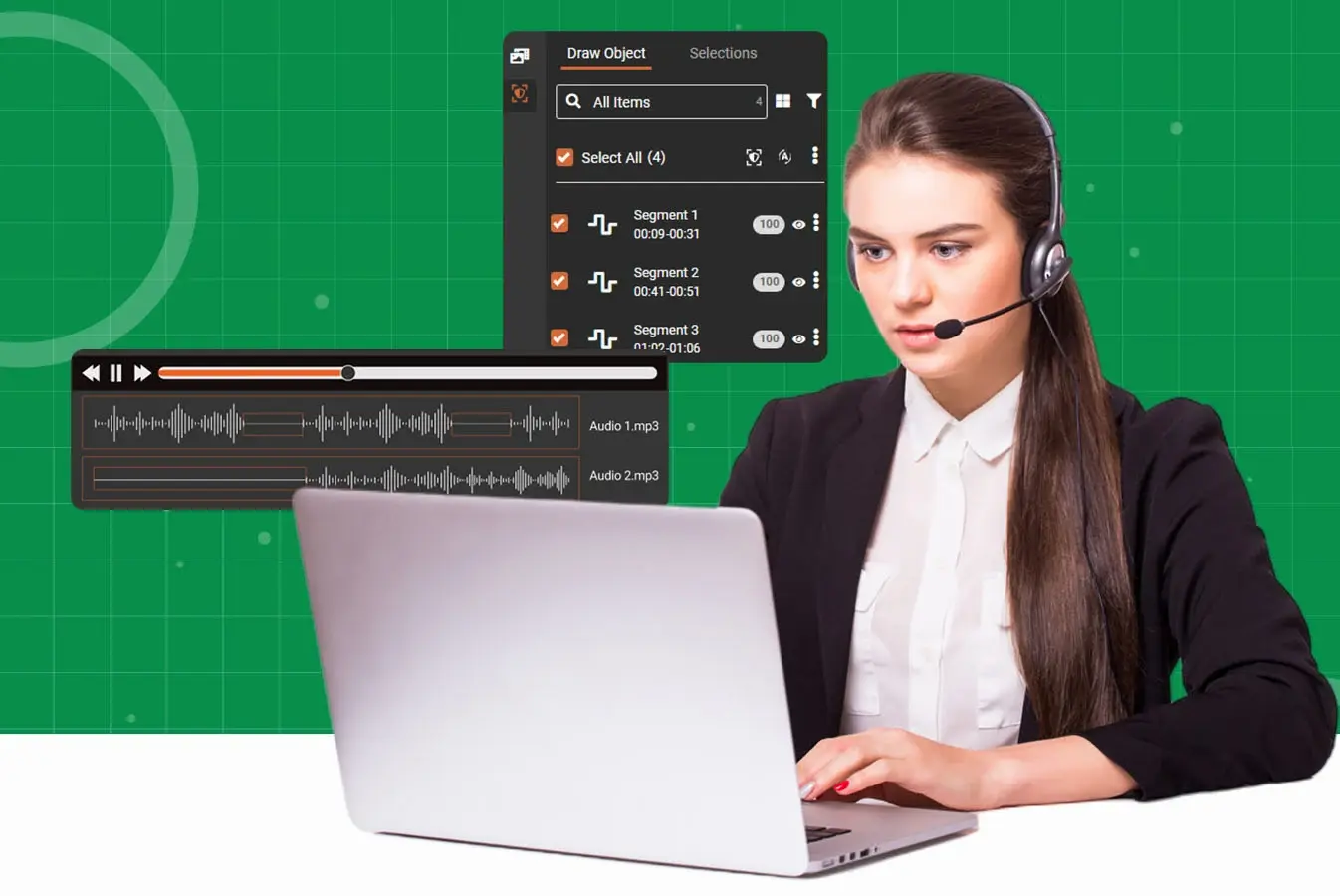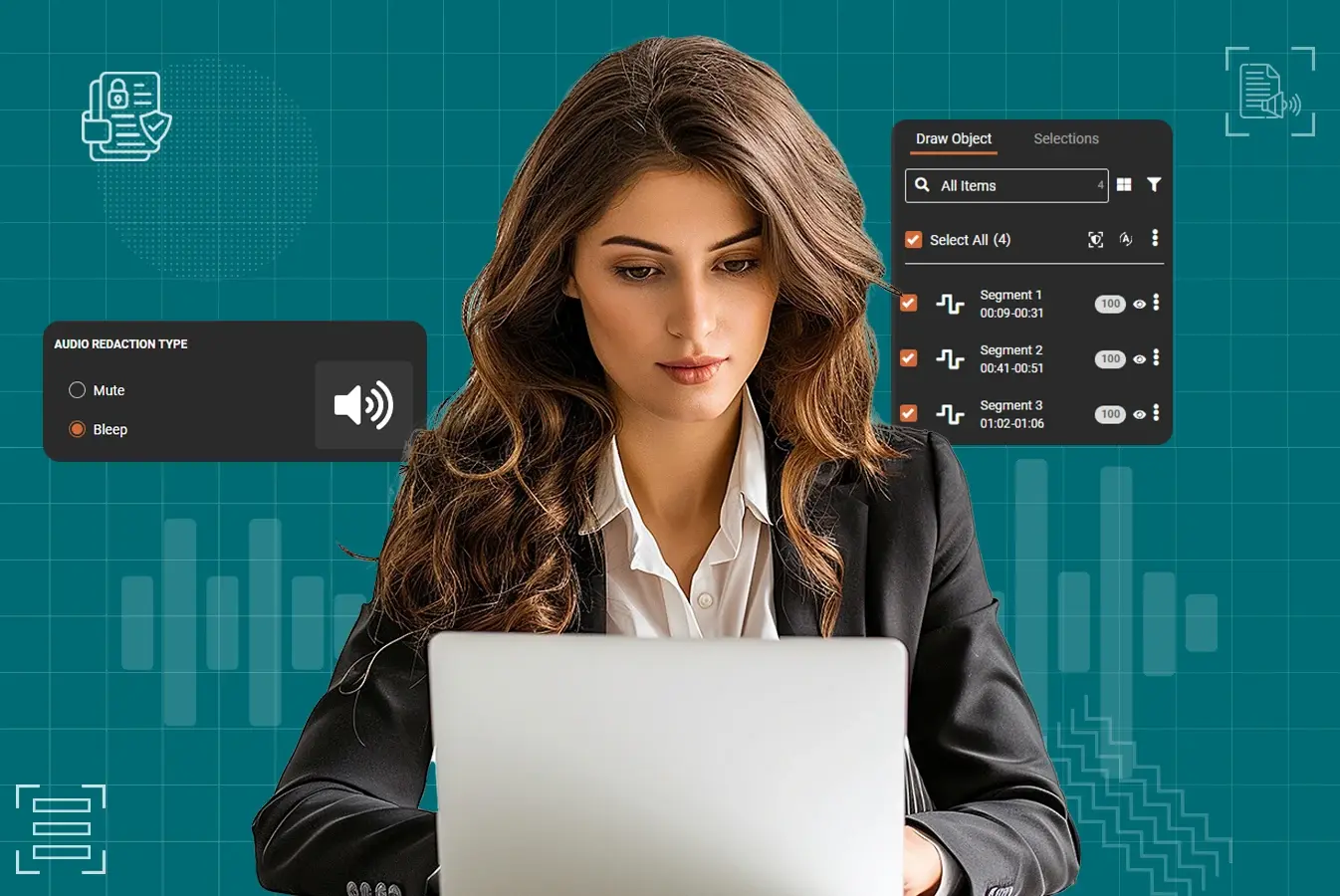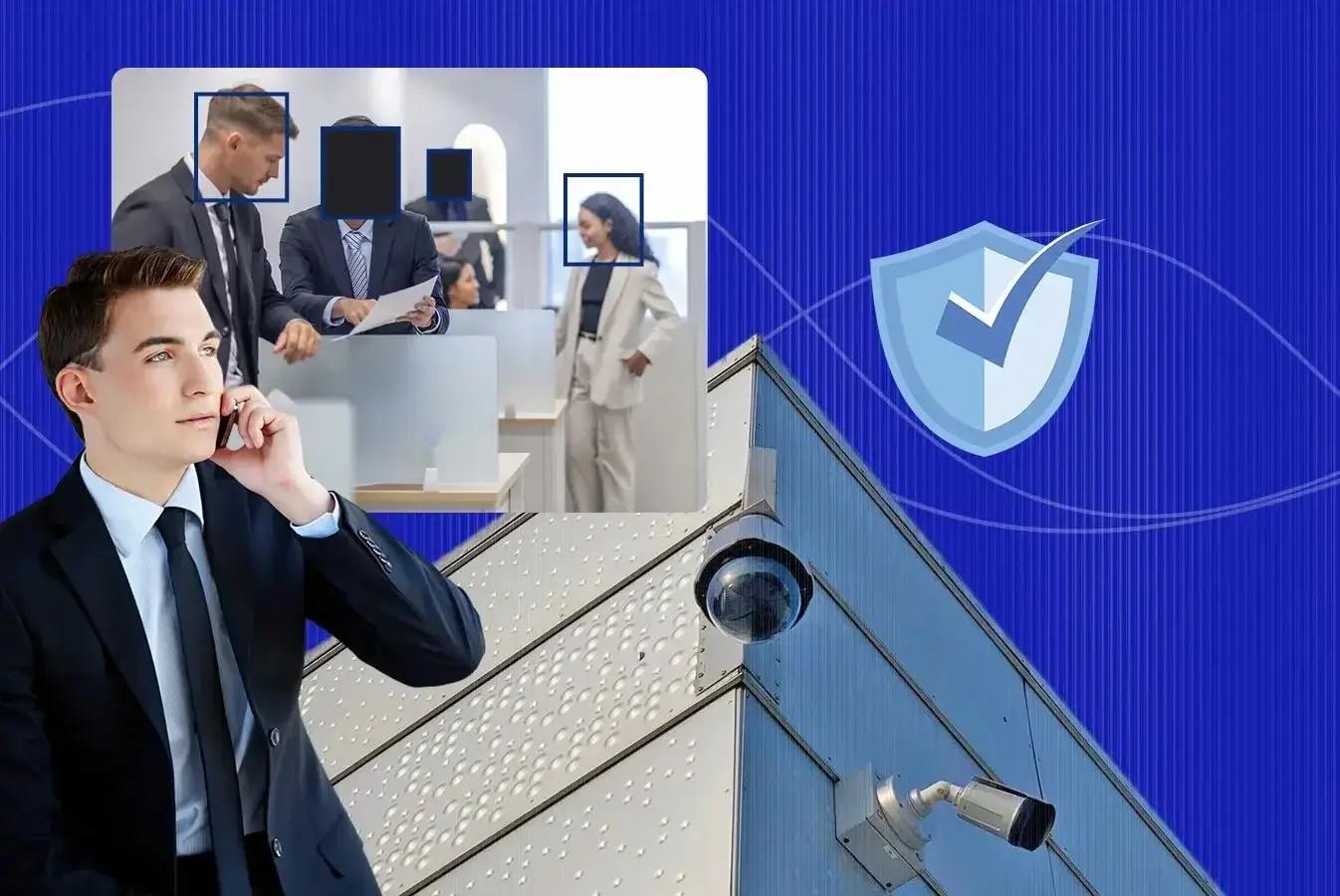How Audio Redaction Software Safeguards Sensitive Audio Recordings
by Rafey Iqbal, Last updated: June 25, 2025, Code:

Imagine the shock when you discover that your data is being treated casually and left at risk of leaks. It’s like finding out your secret diary is shown on a Times Square billboard.
Like you, your customers and people feel the same way. Research by the Pew Research Center, McKinsey and Company, and others reveal that people take data privacy seriously. You must live up to their expectations using audio redaction software to generate redacted audio content.
Breaches of personal data can leave people feeling betrayed. Take the Facebook data scandal, for example, where users were left “Surprised, Shocked, Worried” upon learning how much of their data was being compromised. Anyone would feel the same.
Such incidents can damage an organization’s reputation faster than the spread of a wildfire. Not to mention, violating data protection laws can cost your organization penalties ranging from $50 per record to millions of dollars, even billions sometimes. Did it send chills down your spine? It sure did.
Personal data can also be found anywhere, even in audio files that contain PII (Personally Identifiable Information) and other sensitive data. To comply with regulations and protect privacy, this information must be treated with the utmost care using audio redaction software. This is why redacted audio is a viable solution to protect data integrity.
What is Redacted Audio?
You may have noticed it bleeps out if someone uses slurs or mentions a brand name on TV. This audio is said to be redacted.
For instance, customer call recordings in a call center may contain sensitive information that needs to be protected using audio redaction software. A similar scenario is observed in the banking and financial landscape.
Redacted audio refers to audio clips containing censored snippets. Audio bits with sensitive information can be identified and redacted to hide the sensitive information using audio. This can be done using audio redaction software.
Why Redacted Audio Matters?
Companies that record and store audio containing sensitive client information must keep the data safe and sound. Industries, including but not limited to call centers, law enforcement, and healthcare, take several measures to protect their clients' privacy.
Furthermore, compliances such as HIPAA, FOIA, GDPR, etc., strictly check and balance how companies deal with personal and sensitive data. Failing to comply with their laws can cost your organization a lot. More on this in the later section.
The Relation between Redacted Audio and Compliances
Although data privacy regulations do not target data protection for audio recordings in particular, given the wealth of sensitive details found in audio recordings, they are subject to the following compliances:
- HIPAA
- GDPR
- FOIA
- PCI-DSS
- CRoC
HIPAA
Health Insurance Portability and Accountability Act (HIPAA) covers entities (health providers and health plans) and business associates who collect patient health information (PHI) and are bound to follow the HIPAA rules. HIPAA ensures that an individual’s health information is secured.
PHI data under HIPAA compliance could be any information in any form, including spoken words. The breach of such information is considered a HIPAA violation and a serious crime resulting in penalties.
GDPR
General Data Protection Regulation (GDPR) ensures that EU citizens' privacy is protected and their personally identifiable information is not exposed unnecessarily or misused.
Under Article 9, Article 15, and Article 17 of GDPR, all media formats, including audio files, that contain sensitive data or personally identifiable information must be redacted.
Learn more about the fulfillment of GDPR requirements.
FOIA
Freedom of Information Act (FOIA) protects all confidential records and personal information from misuse with limited access provisions.
The Privacy Act ensures that the records are not accessible to the public or third parties and have the following primary objectives:
- Restrict personally identifiable information from disclosure.
- Grant individuals the right to access information about themselves.
- Establish a code of “fair information practices” that federal agencies must abide by to collect, maintain, and transmit records.
- Grant individuals the right to look for the amendments made to the data about themselves.
Learn about FOIA Rules for redaction.
PCI-DSS
The Payment Card Industry Data Security Standard (PCI-DSS) mandates that financial institutions redact sensitive financial information shared for the purpose of over-the-phone/mail-order-telephone-order (OTP/MOTO) payments.
Here are some examples of the financial information that should be redacted:
- Account numbers
- CVV code
- PIN
- ABA routing numbers
California Rules of Court
As per Rule 1.201 Section (a) of the California Rules of Court, all personal information in court filings must be redacted. Rule 8.83 requires records to be made available for public access.
CRoC requires audio to be redacted before being presented in court to protect the person's confidentiality and not reveal it to the public.
Learn more about California Rules of Court.
Industries That Need Audio Redaction Software
Many industries generate audio data with personal information that needs to be redacted. The following are some of the industries that need audio redaction software to ensure compliance with strict data privacy regulations:
- Call centers
- Law enforcement
- Prosecution
- Healthcare
- Finance
Call Centers
On average, call centers handle 4,400 calls in a month, all recorded for quality assurance and evaluation purposes. Seems harmless, right? Wrong.
Call centers are always facing the threat of increasing data breaches. A single data breach can cost them a fortune. Why exactly?
Because customer calls may contain sensitive financial information that needs to be protected. Audio redaction software in call centers obscures this sensitive information in audio files, ensuring compliance with data protection regulations using automated audio redaction software.
Law Enforcement
Law enforcement officers spend hours daily performing their responsibilities to maintain law and order. However, recordings from 911 dispatch or digital evidence of a case need to be redacted before being shared publicly or with other concerned stakeholders. These recordings may contain PII information that cannot be disclosed officially under most circumstances.
Several laws, such as AB-748 of California, demand, under most circumstances, for records and evidence to be disclosed to the public after a withholding period of 45 calendar days. However, the need to redact PII remains intact; hence, law enforcement needs PII redaction software for redacting audio recordings.
Learn more about redaction in law enforcement.
Prosecution
Audio redaction software is necessary to mask all information that is irrelevant or does not hold any weightage for the case during court presentation.
In the prosecution landscape, the prosecutor and defense must listen to long audio evidence to extract useful information and redact unnecessary or private information about victims or witnesses for court proceedings. Similarly, privileged communications between the attorney and the client must be redacted to respect the attorney-client privilege.
Automated audio redaction can significantly reduce the time required and help legal professionals focus more on the cases while staying compliant with the ABA Model Rules of Professional Conduct and the Federal Rules of Civil Procedure.
Learn more about redaction for prosecution.
Healthcare
Healthcare service providers are among the industries that must collect extensive amounts of crucial patient information as part of their daily operations. The data at hand is confidential and requires privacy protection.
This data can include audio files containing sensitive PHI (Patient Health Information). Healthcare facilities engage with audio recordings through patient-nurse communications recorded for research purposes. This is quite risky if you ask us.
After all, healthcare providers must strictly adhere to the rules and regulations of the Health Insurance Portability and Accountability Act (HIPAA). This act is enforced to ensure patient health information's privacy and security.
Learn more about the need for redaction in healthcare.
Finance
As digital tools are evolving daily, there is also an increase in customers doing business with banks virtually through video conferencing tools and audio calls.
Data from these recordings contain personally identifiable information (PII) like full name, credit card number, social security number, financial information, passport number, and payment card information (PCI) such as Account holders’ number, ID, phone number, email address, pin codes, etc.
This recorded information is becoming a pool for hackers to breach and retrieve confidential information from them. Hence, any unprotected or unredacted PII and PCI data that outsiders or unauthorized users share will lead to a breach and a sheer violation of the Payment Card Industry-Data Security Standard (PCI-DSS), the Gramm-Leach-Bliley Act (GLBA), and the Dodd-Frank Act.
Read about the importance of audio redaction in banks.
4 Ways to Get Redacted Audio Using Audio Redaction Software
Now is the time to uncover the ways to perform audio redaction effectively. Thanks to advanced audio redaction software, the following ways can help streamline the audio redaction process:
.png?width=1576&height=1586&name=image%20(6).png)
- Spoken PII redaction
- Bulk audio redaction
- Transcript-based redaction
- Manual redaction via audio segment
Spoken PII Redaction
As discussed earlier, sensitive information can include PII (Personally Identifiable Information). In audio files, this is in the form of speech. Spoken PII can be automatically identified and masked using PII redaction software without human intervention.
For instance, a recorded call might contain sensitive information like a person's Social Security Number (SSN), which can be used to identify them. Using spoken PII redaction software, the automated audio redaction software automatically marks all SSNs, so there is no need to select them manually. This automatic selection feature saves a lot of time and effort.
Bulk Audio Redaction
Bulk audio redaction software becomes much simpler and easier with the ability to edit multiple audio files in bulk. This audio redaction software feature allows you to simultaneously redact information from numerous recordings.
Let's say you have a sensitive audio segment, such as a name repeated in multiple recordings. Selecting the name just once allows you to redact it from all recordings where it appears.
Did you know that one of the largest counties in California uses VIDIZMO’s automated redaction software to bulk-redact millions of audio recordings?
Transcript-based Redaction
Listening to each spoken word in an audio recording can be time-consuming, involving multiple listening sessions. However, the process becomes much more efficient using transcript-based redaction.
You can quickly pinpoint and redact sensitive speech using redaction software by searching for specific keywords within the transcript. It automatically censors the speech corresponding to your selected transcript, making it a more streamlined and effective solution.
Manual Redaction via Audio Segment
When redacting sensitive information from audio recordings, it's essential to be precise. Sometimes, even small audio segments may contain important information that needs to be removed using redaction tools.
To ensure you don't miss any crucial details, you can zoom in on the audio waveform and manually select the exact length of the segment you want to mute or bleep out. This way, you can be confident that you're redacting only the necessary information while leaving the rest of the audio intact.
Generate Redacted Audio with VIDIZMO's Audio Redaction Software
VIDIZMO Redactor is an advanced, redaction software for redacting audio recordings as well as other forms of media. It offers the following audio redaction capabilities:
- Spoken PII redaction that automatically redacts personally identifiable information (PII) in audio recordings.
- Bulk audio redaction for redacting millions of audio recordings at once.
- Transcript-based redaction for redacting spoken words searches for it in the transcription pane. This also allows you to redact the spoken words from closed captions (CC).
- Manual audio redaction using audio segments that can be expanded for precise redaction at the granular level.
- The ability to mute or bleep spoken words to obtain redacted audio.
Explore more features of VIDIZMO Redactor by visiting our dedicated website.
Or you can sign up for a 7-day free trial to experience it in action.
Why Audio Redaction Software Is Essential
Organizations handling sensitive conversations must ensure compliance with data protection laws by redacting personal and confidential information. Whether it's call center recordings, 911 dispatch calls, or financial transactions, audio redaction software is critical in safeguarding privacy and preventing data breaches.
With increasing regulatory scrutiny from laws like HIPAA, GDPR, FOIA, and PCI-DSS, failing to protect sensitive information can result in hefty penalties and reputational damage. AI-powered audio redaction software automates this process, making it easier to redact personal data while maintaining compliance and operational efficiency.
Looking for a secure and automated solution to protect your organization's audio recordings? Try VIDIZMO Redactor for AI-powered audio redaction and ensure compliance with global privacy laws.
People Also Ask
What is audio redaction software?
Audio redaction software is a tool that automatically detects and removes sensitive information from audio recordings to protect privacy and ensure compliance with data protection regulations. It is widely used in call centers, law enforcement, healthcare, and finance to redact Personally Identifiable Information (PII), Protected Health Information (PHI), and Payment Card Information (PCI).
Why is redacted audio necessary?
Redacted audio ensures that sensitive information like names, addresses, credit card details, and social security numbers are removed from recorded conversations. This helps organizations comply with laws like HIPAA, GDPR, FOIA, and PCI-DSS while preventing data breaches and unauthorized access.
How does audio redaction software work?
AI-powered audio redaction software automatically detects spoken sensitive information in an audio file and removes or masks it using muting or bleeping techniques. Advanced tools like VIDIZMO Redactor offer bulk audio redaction, transcript-based redaction, and manual redaction via audio segments to ensure precision.
Can audio redaction software automatically detect sensitive information?
Yes, AI-driven audio redaction software like VIDIZMO Redactor can automatically identify and redact spoken PII, PHI, and financial data without human intervention. It uses speech recognition and Natural Language Processing (NLP) to detect sensitive words and phrases in real-time.
What is the difference between muting and bleeping in audio redaction?
In audio redaction, muting completely removes the sound from the redacted portion, leaving silence. Bleeping replaces the redacted words with a "beep" sound to indicate that information has been removed. Organizations can choose either method based on compliance requirements.
Does audio redaction software support bulk redaction?
Yes, bulk audio redaction allows organizations to redact multiple recordings simultaneously, saving time and improving efficiency. VIDIZMO Redactor offers bulk processing, making it easier for businesses to comply with data privacy regulations without manual intervention.
What are the legal requirements for audio redaction?
Laws such as HIPAA, GDPR, FOIA, and PCI-DSS mandate the protection of sensitive data in recorded conversations. Organizations that fail to comply with these regulations may face legal action, fines, and reputational damage. Using audio redaction software helps meet these compliance standards.
How does transcript-based audio redaction work?
Transcript-based redaction converts spoken words into text and allows users to search for specific keywords to redact them from both the text transcript and audio file. This method ensures precise redaction without needing to listen to the entire recording.
How can I try AI-powered audio redaction software?
You can experience AI-driven audio redaction by signing up for VIDIZMO Redactor’s free trial. It offers automated, bulk, and transcript-based redaction to ensure compliance and security in managing sensitive audio recordings.
Jump to
You May Also Like
These Related Stories

Ensure Data Privacy and Compliance with Bulk Audio Redaction Software

Key Factors to Consider When Choosing Video Redaction Software


No Comments Yet
Let us know what you think